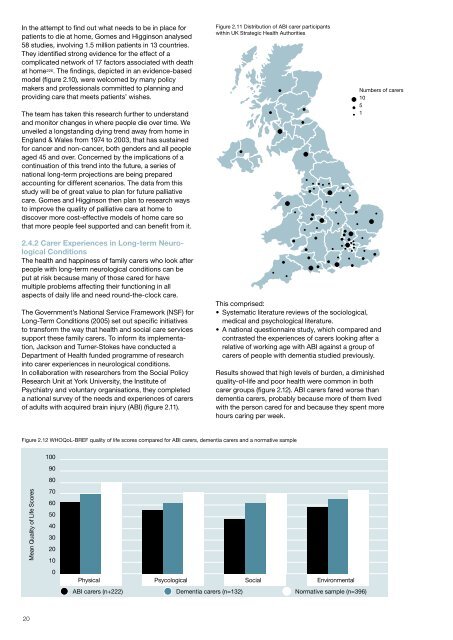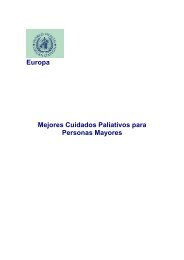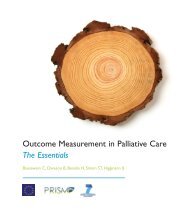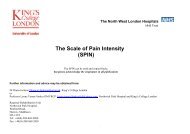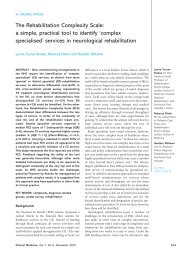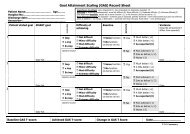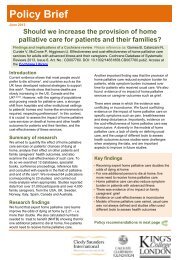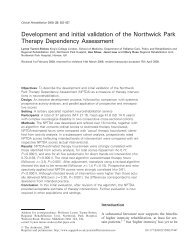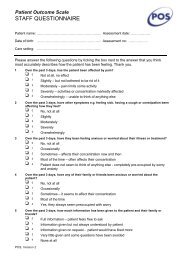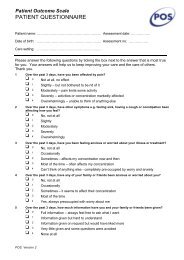2004 - 2007 - Cicely Saunders Institute - King's College London
2004 - 2007 - Cicely Saunders Institute - King's College London
2004 - 2007 - Cicely Saunders Institute - King's College London
You also want an ePaper? Increase the reach of your titles
YUMPU automatically turns print PDFs into web optimized ePapers that Google loves.
In the attempt to find out what needs to be in place for<br />
patients to die at home, Gomes and Higginson analysed<br />
58 studies, involving 1.5 million patients in 13 countries.<br />
They identified strong evidence for the effect of a<br />
complicated network of 17 factors associated with death<br />
at home 226 . The findings, depicted in an evidence-based<br />
model (figure 2.10), were welcomed by many policy<br />
makers and professionals committed to planning and<br />
providing care that meets patients’ wishes.<br />
The team has taken this research further to understand<br />
and monitor changes in where people die over time. We<br />
unveiled a longstanding dying trend away from home in<br />
England & Wales from 1974 to 2003, that has sustained<br />
for cancer and non-cancer, both genders and all people<br />
aged 45 and over. Concerned by the implications of a<br />
continuation of this trend into the future, a series of<br />
national long-term projections are being prepared<br />
accounting for different scenarios. The data from this<br />
study will be of great value to plan for future palliative<br />
care. Gomes and Higginson then plan to research ways<br />
to improve the quality of palliative care at home to<br />
discover more cost-effective models of home care so<br />
that more people feel supported and can benefit from it.<br />
Figure 2.11 Distribution of ABI carer participants<br />
within UK Strategic Health Authorities<br />
Numbers of carers<br />
10<br />
5<br />
1<br />
2.4.2 Carer Experiences in Long-term Neurological<br />
Conditions<br />
The health and happiness of family carers who look after<br />
people with long-term neurological conditions can be<br />
put at risk because many of those cared for have<br />
multiple problems affecting their functioning in all<br />
aspects of daily life and need round-the-clock care.<br />
The Government’s National Service Framework (NSF) for<br />
Long-Term Conditions (2005) set out specific initiatives<br />
to transform the way that health and social care services<br />
support these family carers. To inform its implementation,<br />
Jackson and Turner-Stokes have conducted a<br />
Department of Health funded programme of research<br />
into carer experiences in neurological conditions.<br />
In collaboration with researchers from the Social Policy<br />
Research Unit at York University, the <strong>Institute</strong> of<br />
Psychiatry and voluntary organisations, they completed<br />
a national survey of the needs and experiences of carers<br />
of adults with acquired brain injury (ABI) (figure 2.11).<br />
This comprised:<br />
• Systematic literature reviews of the sociological,<br />
medical and psychological literature.<br />
• A national questionnaire study, which compared and<br />
contrasted the experiences of carers looking after a<br />
relative of working age with ABI against a group of<br />
carers of people with dementia studied previously.<br />
Results showed that high levels of burden, a diminished<br />
quality-of-life and poor health were common in both<br />
carer groups (figure 2.12). ABI carers fared worse than<br />
dementia carers, probably because more of them lived<br />
with the person cared for and because they spent more<br />
hours caring per week.<br />
Figure 2.12 WHOQoL-BREF quality of life scores compared for ABI carers, dementia carers and a normative sample<br />
100<br />
90<br />
80<br />
Mean Quality of Life Scores<br />
70<br />
60<br />
50<br />
40<br />
30<br />
20<br />
10<br />
0<br />
Physical Psycological Social Environmental<br />
ABI carers (n+222) Dementia carers (n=132) Normative sample (n=396)<br />
20


